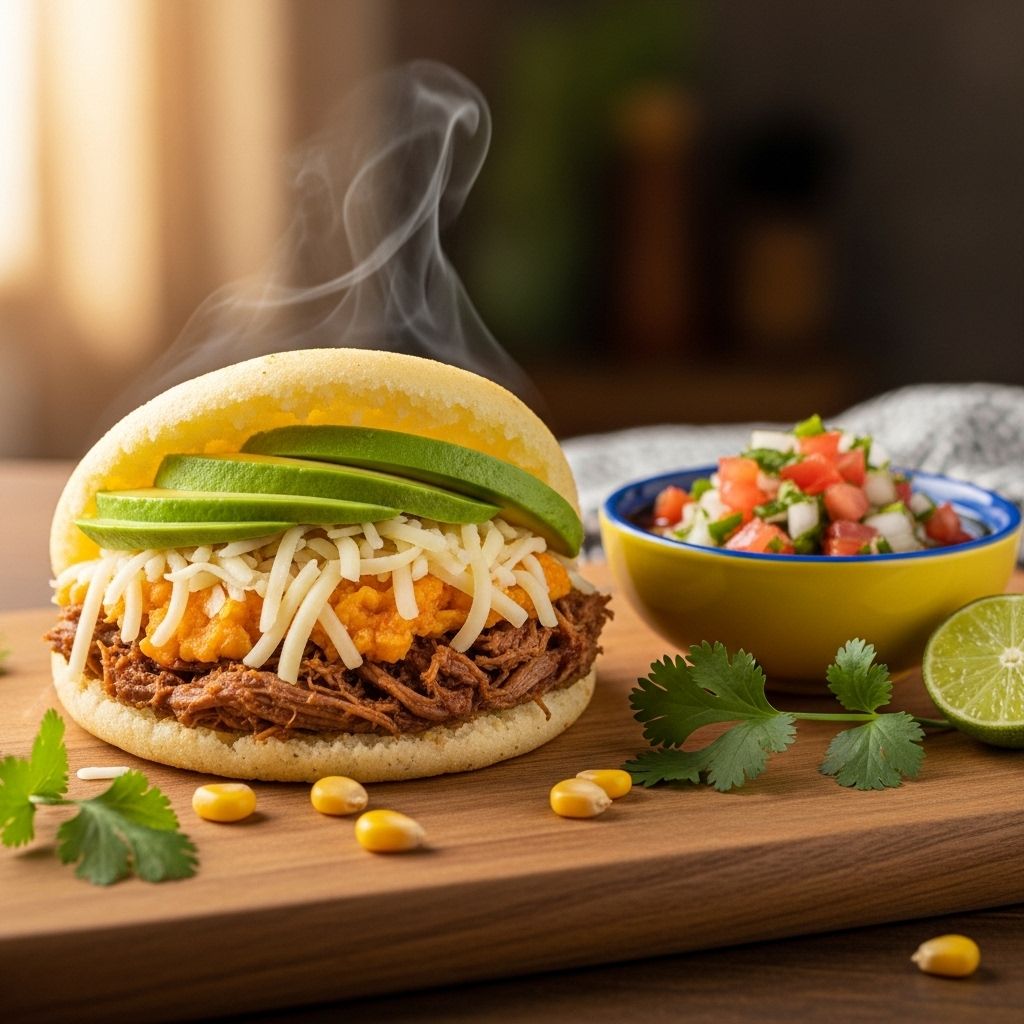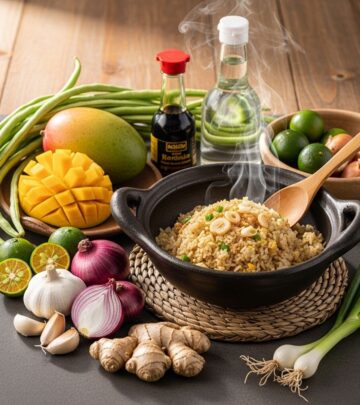Colombian Arepas Recipe: Step-By-Step Homemade Guide
Master the art of making authentic Colombian arepas at home, complete with cheesy goodness, serving tips, and expert FAQs.

Image: HearthJunction Design Team
Colombian Arepas: The Complete Homemade Guide
Colombian arepas are a beloved staple of Latin American cuisine, celebrated for their crispy exterior, soft interior, and the delicious addition of gooey cheese. Eaten at breakfast, lunch, or dinner, these cornmeal cakes are the pride of Colombian households and are gaining worldwide popularity thanks to their delicious simplicity and endless versatility. In this comprehensive guide, you’ll learn what arepas are, the ingredients you need to make them, step-by-step directions, creative serving suggestions, variations, storage tips, and answers to the most frequently asked questions.
What Are Colombian Arepas?
Arepas are round, thick cornmeal cakes originating from Colombia and Venezuela, made with pre-cooked cornmeal (masarepa), water, salt, and sometimes butter or cheese. Colombian arepas, especially the cheesy variation, are renowned for their rich, satisfying flavor and hearty texture. Soft and tender on the inside with a crisp, golden-brown crust, they serve as the perfect base for a variety of fillings or toppings—or shine simply on their own.
Ingredients for Authentic Colombian Arepas
- 1 cup warm water
- 1 cup pre-cooked white cornmeal (such as P.A.N.)
- 1 cup shredded mozzarella cheese
- 1 tablespoon butter
- 1/2 teaspoon salt (or to taste)
- Cooking spray (for greasing the skillet or griddle)
Note: This recipe traditionally yields 6 arepas. You can double or halve the quantities as needed.
Ingredient Notes
- Pre-cooked white cornmeal (masarepa): Essential for proper texture. Popular brands include P.A.N. and Areparina. Do not substitute with raw cornmeal or polenta, as the results will differ significantly.
- Cheese: Mozzarella is classic for its melt and stretch, but other mild semi-soft cheeses like queso fresco, cheddar, or Monterey Jack can also be used.
- Butter: Adds richness and extra flavor. Unsalted is preferred, but salted can be used—just reduce the added salt accordingly.
Step-by-Step Directions
- Mix the Dough:
- In a large bowl, combine warm water, salt, and butter. Stir until the butter melts and the salt dissolves.
- Gradually add the pre-cooked white cornmeal, stirring constantly to avoid lumps.
- Mix in the shredded mozzarella cheese, kneading gently until a smooth, soft, and pliable dough forms. If the dough feels too sticky, add a tablespoon of cornmeal. If too dry, add a splash of warm water.
Looking for a super simple method to whip up your arepas? Discover our Easy 3-Ingredient Method to make perfect savory corn cakes. This approach simplifies the process while still delivering authentic flavor, making it ideal for busy weeknights. - Shape the Arepas:
- Divide the dough into 6 equal portions. Roll each into a ball between your hands.
- Flatten each ball into a patty about 1/2 inch thick and 3-4 inches in diameter. The edges should be smooth and the thickness even for consistent cooking.
For a delightful variation, explore our Colombian Arepas de Huevo Recipe that introduces a crispy fried corn cake filled with egg. This dish is perfect for those craving a hearty twist on the classic arepa, combining flavors and textures that will please anyone. - Preheat and Prep:
- Lightly grease a non-stick skillet or griddle with cooking spray. Heat over medium heat.
- Cook the Arepas:
- Place the shaped arepas on the hot skillet. Cook for about 5-7 minutes per side, until golden brown and a slightly crisp crust forms. Flip once halfway through.
- The cheese inside will melt, creating a gooey center while the exterior develops a signature crunch.
- Optional Finish (for extra crispiness):
- After pan-cooking, you may bake the arepas at 350°F (175°C) for 5–10 minutes on a baking sheet to ensure they are cooked through and achieve extra crunch.
- Serve:
- Let the arepas cool for a minute or two. Slice partially through each arepa with a serrated knife to form a pocket, if desired, or serve whole.
Serving Suggestions
Arepas are delicious right off the griddle or baking sheet, but they can also be enjoyed with an array of toppings and fillings. Here are some classic and creative ways to serve Colombian arepas:
- Plain with Butter: Enjoy arepas simply warm with a pat of butter melting into the steaming interior.
- Stuffed with Cheese: Cut a slit and add more cheese inside, then return to the skillet briefly to melt.
- With Eggs: Top with scrambled or fried eggs for a hearty breakfast.
- With Avocado: Add sliced avocado or guacamole for a creamy, fresh bite.
- With Meats: Fill with shredded chicken, beef, or sausage for a protein-packed meal.
- With Beans or Plantains: Pair with black or pinto beans, or sweet plantain slices for a traditional Colombian touch.
- As a Side: Serve arepas alongside stews, soups, or salads to complete a meal.
Tips for Perfect Arepas Every Time
- Consistency: Pay attention to the dough. It should be soft but not sticky. Add cornmeal or water as needed to adjust.
- Resting the Dough: Letting the dough rest for 5-10 minutes before shaping helps it firm up and makes shaping easier.
- Even Thickness: Make sure your arepas are uniform in thickness to ensure even cooking and the perfect bite.
- Don’t Overcrowd the Skillet: Cook arepas in batches to ensure each one cooks evenly and gets a nice, golden crust.
- Sound Test: Tap the cooked arepa; it should sound hollow when fully done inside.
Popular Variations
Colombian arepas are endlessly adaptable. Here are a few popular twists:
- Arepas de Queso (Cheese Arepas): Add extra cheese to the dough or stuff additional cheese in the center before cooking for a true cheese lover’s treat.
- Arepas with Milk: Substitute some or all of the water with milk for a richer, creamier flavor.
- Sweet Arepas: Mix in a tablespoon of sugar or sweetened condensed milk for a dessert version. Serve with jam or honey.
- Whole Corn or Vegetables: Fold in corn kernels or finely diced vegetables for extra color and nutrition.
- Grilled Arepas: After pan-frying, finish on the grill for a smoky flavor and beautiful grill marks.
Nutrition Information
| Nutrition Facts (per arepa) | Amount |
|---|---|
| Calories | ~180 |
| Fat | 7g |
| Saturated Fat | 3g |
| Carbohydrates | 22g |
| Protein | 6g |
| Sodium | 260mg |
Nutrition amounts will vary depending on the exact cheese used, size of the arepas, and cooking method.
Storage and Reheating Tips
- Storing: Allow arepas to cool completely. Store in an airtight container in the refrigerator for up to 3 days.
- Freezing: Place cooled arepas in a single layer in a freezer bag, separated by parchment paper. Freeze for up to 2 months.
- Reheating: Warm refrigerated or frozen arepas in a skillet over medium-low heat for 3-5 minutes per side, or microwave briefly to soften and then toast for more crunch. Avoid overheating to prevent drying.
Frequently Asked Questions (FAQs)
What kind of cornmeal should I use?
Always use pre-cooked white cornmeal (masarepa) such as P.A.N. or Areparina. Regular cornmeal or corn flour will not yield the authentic arepa texture.
Can I make arepas without cheese?
Yes! You can omit the cheese for a more basic arepa, or substitute with other fillings such as meats, beans, or vegetables as preferred.
How do I know when arepas are fully cooked?
Arepas are done when both sides are golden brown, the crust is crisp, and tapping them makes a hollow sound. Optionally, bake them briefly after pan-cooking to ensure the inside is cooked through.
Can I prepare the dough ahead of time?
Yes, you can mix the dough a few hours ahead and keep it covered with a damp cloth in the refrigerator. Let it return to room temperature before shaping and cooking.
What do I do if my dough is too dry or too wet?
If too dry, add a teaspoon of warm water at a time and knead. If too wet or sticky, add small amounts of cornmeal until the texture is right.
Are arepas gluten-free?
Yes, as long as you use gluten-free labeled pre-cooked cornmeal, arepas are naturally gluten-free.
Can I bake arepas instead of pan-frying?
Absolutely. Bake arepas in a preheated 350°F (175°C) oven for about 15–20 minutes, flipping once, until browned and cooked through. This method is less oily and can yield a crunchier crust.
Final Thoughts
Colombian arepas are a cornerstone of comfort food in Latin American cuisine, offering simplicity, adaptability, and irresistible flavor. Whether served plain, stuffed with cheese, or topped with your favorite savory ingredients, they are sure to become a new favorite in your kitchen. Try this easy recipe, experiment with fillings, and bring the authentic taste of Colombia to your table today.
References
Read full bio of Shinta












